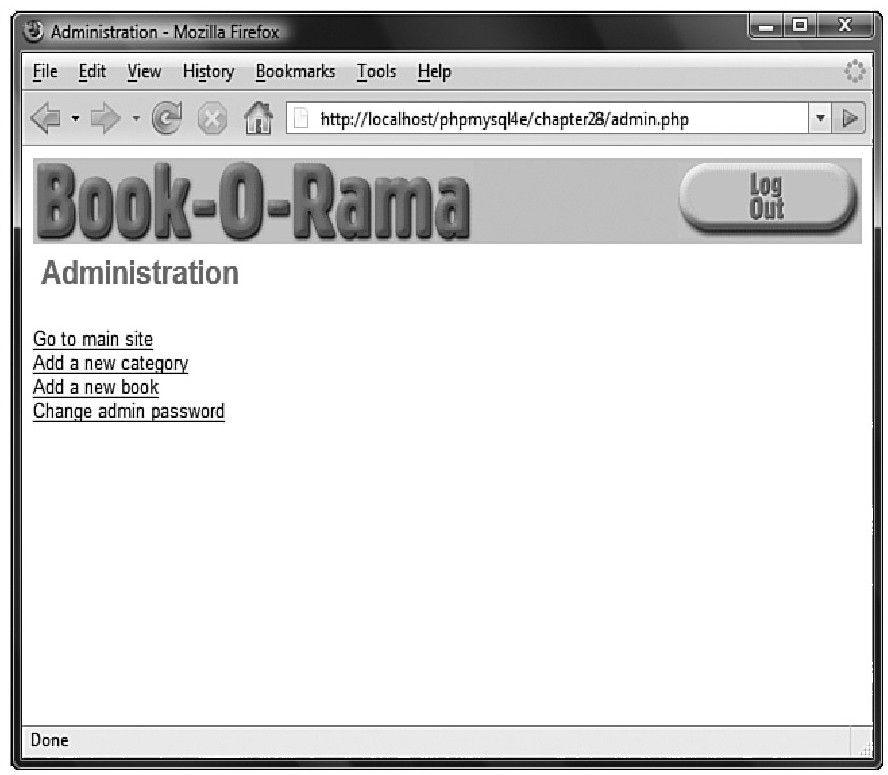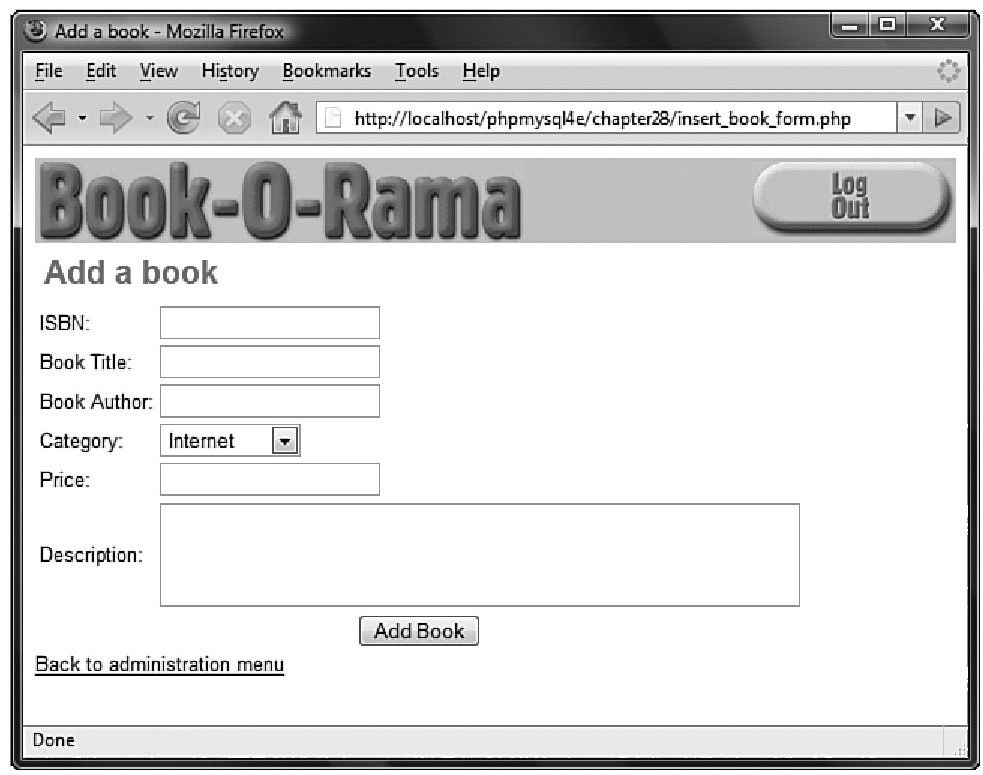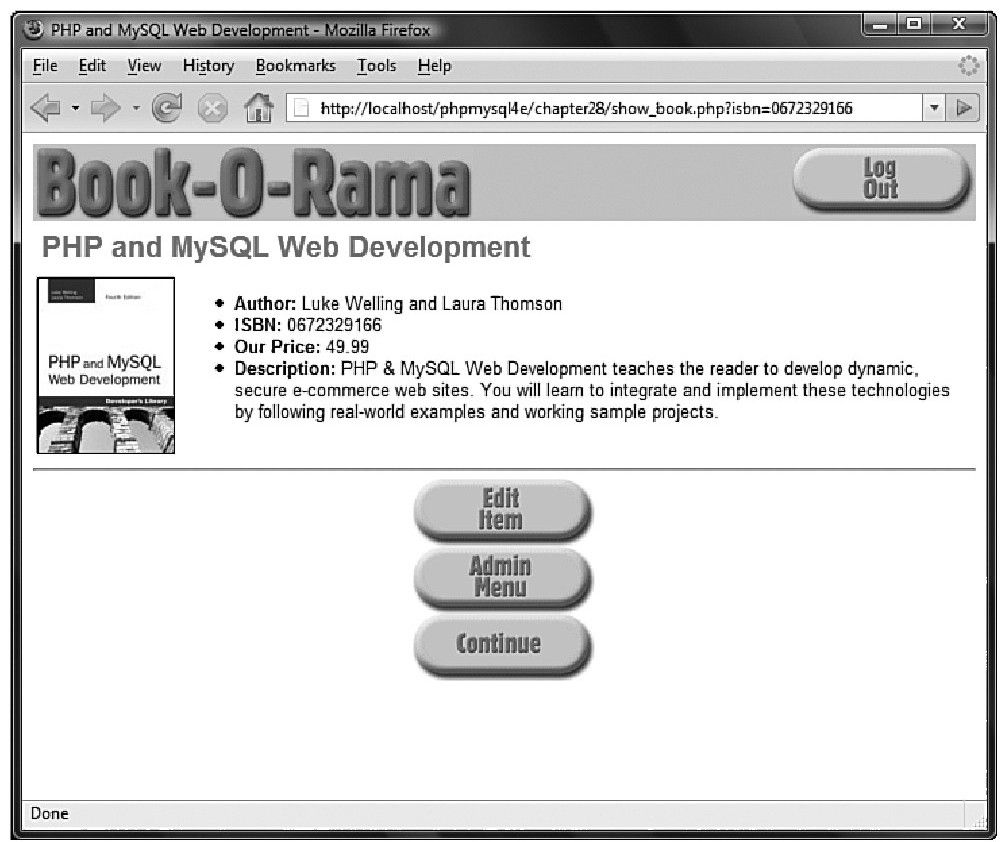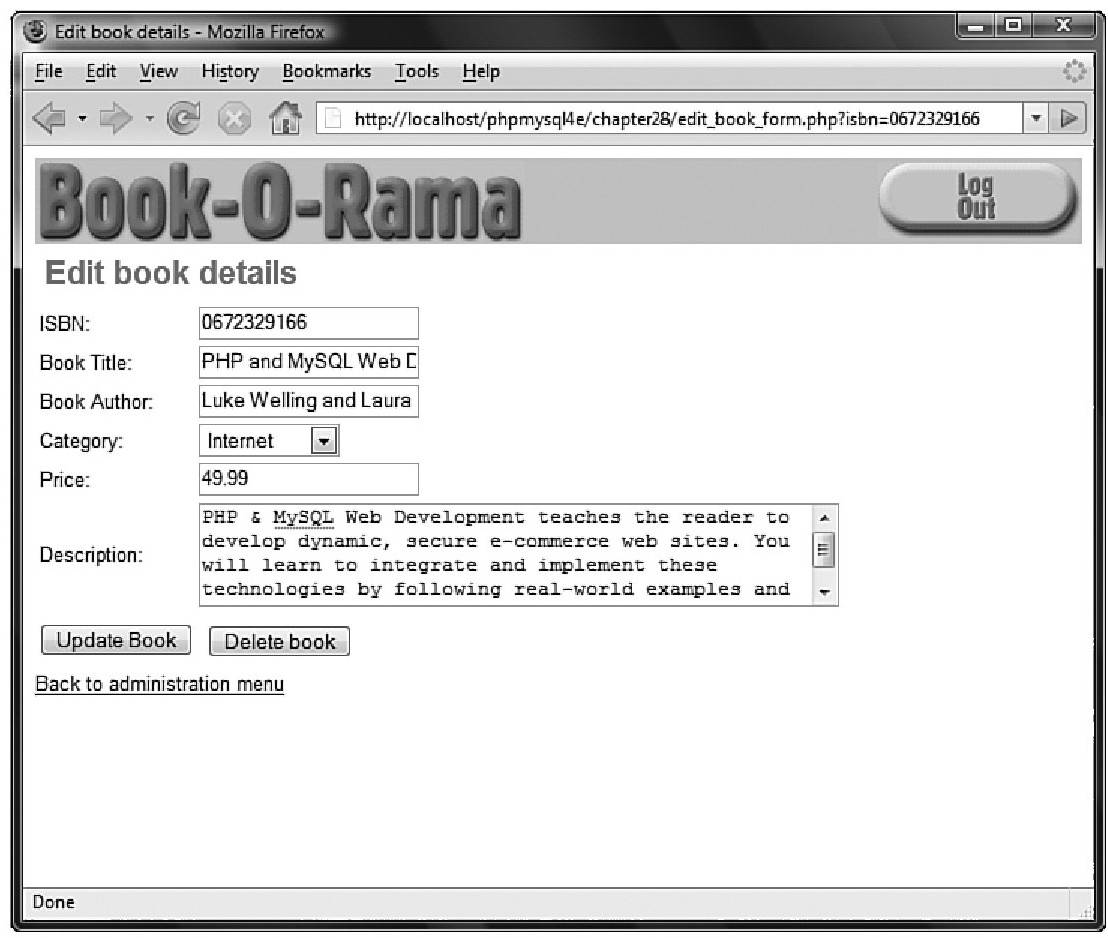我们实现的管理界面非常简单。创建一个网站界面,该页面可以连接数据库,并且执行一些前台的身份验证。这些代码与第27章中用到的代码非常类似。出于完整性考虑,我们还是在这里给出了这些代码,但对它不做具体的介绍。
管理界面需要用户通过login.php文件进行登录,该文件会将用户带入到管理菜单admin.php中。登录界面如图28-11所示。(为了简洁起见,我们没有给出login.php的代码——该文件与第27章中介绍的几乎一样,如果要查看这个文件,可以在附带的文件中找到这个文件。)管理菜单如图28-12所示。
 图 28-11 用户通过登录页才能访问管理功能
图 28-11 用户通过登录页才能访问管理功能  图 28-12 管理菜单允许用户访问管理函数
图 28-12 管理菜单允许用户访问管理函数管理菜单的代码如程序清单28-17所示。
程序清单28-17 admin.php——该脚本将验证管理员身份并允许他访问管理功能
<?php
//include function files for this application
require_once(\'book_sc_fns.php\');
session_start;
if(($_POST[\'username\'])&&($_POST[\'passwd\'])){
//they have just tried logging in
$username=$_POST[\'username\'];
$passwd=$_POST[\'passwd\'];
if(login($username,$passwd)){
//if they are in the database register the user id
$_SESSION[\'admin_user\']=$username;
}else{
//unsuccessful login
do_html_header(\"Problem:\");
echo\"<p>You could not be logged in.<br/>
You must be logged in to view this page.</p>\";
do_html_url(\'login.php\',\'Login\');
do_html_footer;
exit;
}
}
do_html_header(\"Administration\");
if(check_admin_user){
display_admin_menu;
}else{
echo\"<p>You are not authorized to enter the administration area.</p>\";
}
do_html_footer;
?>
这段代码看起来有点熟悉;它与第27章中的一段脚本类似。管理员到达这个页面之后,可以修改密码或者退出——该代码与第27章中的代码完全一样,因此在这里不再介绍。
我们在管理员登录之后通过会话变量admin_user和check_admin_user函数来识别其身份。该函数和其他被管理员脚本调用的函数一样,都可以在函数库admin_fns.php中找到。
如果管理员选择添加一个新的目录或图书,可以根据具体情况进入insert_category_form.php或insert_book_form.php文件。每个脚本都会向管理员提供一个表单,该表单必须由管理员填写。每个表单都由相应的脚本来处理(insert_category.php和insert_book.php),这些脚本将检查表单是否填好并将数据插入到数据库中。在这里,我们只讨论添加图书的脚本,因为添加图书的脚本和添加目录的脚本类似。
insert_book_form.php脚本的输出结果如图28-13所示。
 图 28-13 该表单允许管理员输入新书到在线目录
图 28-13 该表单允许管理员输入新书到在线目录注意图书的目录域是一个HTML的SELECT元素。SELECT的选项来自对get_categories函数的调用,前面我们已经介绍了该函数。
点击\"Add Book\"按钮之后,将触发insert_book.php脚本的执行。该脚本的代码如程序清单28-18所示。
程序清单28-18 insert_book.php——该脚本将验证新书数据并将它添加到数据库
<?php
//include function files for this application
require_once(\'book_sc_fns.php\');
session_start;
do_html_header(\"Adding a book\");
if(check_admin_user){
if(filled_out($_POST)){
$isbn=$_POST[\'isbn\'];
$title=$_POST[\'title\'];
$author=$_POST[\'author\'];
$catid=$_POST[\'catid\'];
$price=$_POST[\'price\'];
$description=$_POST[\'description\'];
if(insert_book($isbn,$title,$author,$catid,$price,$description)){
echo\"<p>Book<em>\".stripslashes($title).\"</em>was added to the
database.</p>\";
}else{
echo\"<p>Book<em>\".stripslashes($title).\"</em>could not be
added to the database.</p>\";
}
}else{
echo\"<p>You have not filled out the form.Please try again.</p>\";
}
do_html_url(\"admin.php\",\"Back to administration menu\");
}else{
echo\"<p>You are not authorised to view this page.</p>\";
}
do_html_footer;
?>
可以看到,该脚本调用了函数insert_book。该函数和其他管理脚本调用的函数一样,都可以在函数库admin_fns.php中找到。
除了添加新目录和新书,管理员还可以编辑和删除它们。我们已经重用了尽可能多的脚本来实现这些功能。当管理员点击管理菜单页面中的\"Go to Main Site\"链接时,将回到index.php中的目录索引,并且与普通用户一样使用同样的脚本接受该索引的导航。
然而,管理导航之间不完全相同:管理员将看到不同的选项,这些选项是根据他们已经注册的会话变量admin_user来确定的。例如,如果我们查看一下本章前面介绍的show_book.php页,将看到一些不同的菜单选项,如图28-14所示。
 图 28-14 show_book.php脚本为管理员用户生成不同的输出
图 28-14 show_book.php脚本为管理员用户生成不同的输出管理员可以访问该页面中的两个新增选项:\"Edit Item\"和\"Admin Menu\"。注意在页面的右上角我们看不到购物车——取而代之的是一个\"Log Out\"按钮。
这些代码都在程序清单28-8中列出,如下所示:
if(check_admin_user){
display_button(\"edit_book_form.php?isbn=\".$isbn,\"edit-item\",\"Edit Item\");
display_button(\"admin.php\",\"admin-menu\",\"Admin Menu\");
display_button($target,\"continue\",\"Continue\");
}
如果回头看看show_cat.php脚本,将发现它也有这些内置选项。
如果管理员点击\"Edit Item\"按钮,将进入edit_book_form.php脚本。该脚本的输出如图28-15所示。
 图 28-15 edit_book_form.php脚本使管理员可以编辑图书的详细信息或者删除一本书
图 28-15 edit_book_form.php脚本使管理员可以编辑图书的详细信息或者删除一本书实际上,这是我们前面用来获取图书详细信息的同一个表单。我们建立了一个指向该表单的选项用来传入和显示现存的图书数据。对于目录,同样如此。要明白为什么目录操作也是如此,请参阅程序清单28-19。
程序清单28-19 admin_fns.php文件中的display_book_form函数——该表单完成了两项工作:插入图书和编辑图书
function display_book_form($book=\'\'){
//This displays the book form.
//It is very similar to the category form.
//This form can be used for inserting or editing books.
//To insert,don\'t pass any parameters.This will set$edit
//to false,and the form will go to insert_book.php.
//To update,pass an array containing a book.The
//form will be displayed with the old data and point to update_book.php.
//It will also add a\"Delete book\"button.
//if passed an existing book,proceed in\"edit mode\"
$edit=is_array($book);
//most of the form is in plain HTML with some
//optional PHP bits throughout
?>
<form method=\"post\"
action=\"<?php echo$edit?\'edit_book.php\':\'insert_book.php\';?>\">
<table border=\"0\">
<tr>
<td>ISBN:</td>
<td><input type=\"text\"name=\"isbn\"
/></td>
</tr>
<tr>
<td>Book Title:</td>
<td><input type=\"text\"name=\"title\"
/></td>
</tr>
<tr>
<td>Book Author:</td>
<td><input type=\"text\"name=\"author\"
/></td>
</tr>
<tr>
<td>Category:</td>
<td><select name=\"catid\">
<?php
//list of possible categories comes from database
$cat_array=get_categories;
foreach($cat_array as$thiscat){
echo\"<option value=\"\".$thiscat[\'catid\'].\"\"\";
//if existing book,put in current catgory
if(($edit)&&($thiscat[\'catid\']==$book[\'catid\'])){
echo\"selected\";
}
echo\">\".$thiscat[\'catname\'].\"</option>\";
}
?>
</select>
</td>
</tr>
<tr>
<td>Price:</td>
<td><input type=\"text\"name=\"price\"
/></td>
</tr>
<tr>
<td>Description:</td>
<td><textarea rows=\"3\"cols=\"50\"
name=\"description\">
<?php echo$edit?$book[\'description\']:\'\';?>
</textarea></td>
</tr>
<tr>
<td<?php if(!$edit){echo\"colspan=2\";}?>>
<?php
if($edit)
//we need the old isbn to find book in database
//if the isbn is being updated
echo\"<input type=\"hidden\"name=\"oldisbn\"
value=\"\".$book[\'isbn\'].\"\"/>\";
?>
<input type=\"submit\"
/>
</form></td>
<?php
if($edit){
echo\"<td>
<form method=\"post\"action=\"delete_book.php\">
<input type=\"hidden\"name=\"isbn\"
value=\"\".$book[\'isbn\'].\"\"/>
<input type=\"submit\"value=\"Delete book\"/>
</form></td>\";
}
?>
</td>
</tr>
</table>
</form>
<?php
}
如果我们传入一个包含图书数据的数组,该表单将显示为编辑模式,并用数组中的数据填充其中的域,如下所示:
<input type=\"text\"name=\"price\"
/><
我们甚至可以得到一个不同的提交按钮。实际上,对编辑表单,我们有两个脚本——一个用来更新图书,而另一个用来删除图书。这两个脚本分别称为edit_book.php和delete_book.php,它们都要相应地更新数据库。
从工作原理来说,目录版本与图书版本的脚本是相同的,但有一点不同的是,当管理员删除一个目录的时候,如果该目录仍然包含有图书,那么该目录不可删除(这需要通过数据库查询进行检查),这避免了任何不正常删除的问题。在第8章中我们讨论过这样的问题。在这种情况下,如果一个目录还有图书包含在内,就被直接删除,那么这些书将成为“孤儿”。我们不知道它们属于哪个目录,也不知道如何查找它们!
以上就是对管理界面的概述。要了解更多信息,请参阅代码——它们都可在附带的文件里找到。
